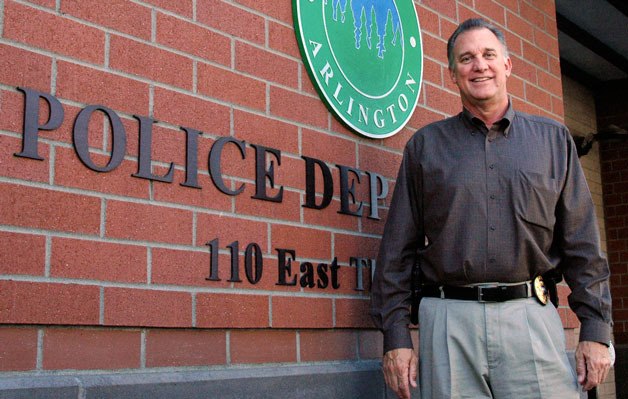ARLINGTON — Lisa Wojciechowicz tries to have her eyes and ears on students as best she can.
Her duties include patrolling Arlington High School and the school district’s middle schools, “gathering intel” by approaching students and asking them about what’s happening in their lives.
“The kids are more comfortable to talk to than most parents are,” said Wojciechowicz, an Arlington Police Department officer and the student resource officer for the Arlington School District. “I talk to the kids that are at risk and try to let them know how to make better choices.”
So when whispers of gang activity crop up, she is oftentimes the first person to know about it.
City police and school district officials have said that Arlington does not have a gang problem, but that hasn’t stopped them from enacting ordinances and making plans in case one does crop up.
“It’s much easier to hold a hill,” Wojciechowicz said. “We don’t want them to get a foothold in our town.”
Graffiti and public perception
Earlier this month the Arlington City Council passed an ordinance that would fine property owners $100 per day for graffiti left unabated on their properties.
Arlington Police Chief Robert Sullenberger presented the proposed ordinance to the City Council during a work session Sept. 28 and the Council approved the measure Monday, Oct. 5.
During Sullenberger’s presentation to the Council, he said that only about 35 percent of all graffiti is gang related. However, graffiti can generate a public perception of blight, increasing community members’ fear of gang activity.
The police chief said although Arlington has not had many instances of graffiti within its city limits, having an ordinance in place will make a difference if gang activity becomes a bigger issue in the future.
Arlington is located between two cities that “have a gang problem” according to a city memo — Mount Vernon and Marysville.
Sullenberger said he hopes the ordinance will keep gang-related activity, such as graffiti, from spreading into Arlington.
National studies have shown that removing graffiti within 24-48 hours after it has been placed is a major deterrent, Sullenberger said.
“This would give us a tool to use if we get inundated with graffiti,” Sullenberger told the Council during the September work session.
City surrounded by gang influences
Most of the city’s graffiti comes from teenagers, not gang members, according to data collected by authorities in the summer of 2008.
But police officers do see their fair share of gang tags, suggesting there is some gang presence in the area, Wojciechowicz told the Arlington City Council in August.
“But most of it isn’t home-grown,” she said.
Area gangs mostly come from Lynnwood and Everett, Wojciechowicz said, adding that 49 different gangs have been identified within Snohomish County. Of those, six gangs have been identified in the Marysville/Arlington area.
Ann Plunkett, the Snohomish County Sheriff’s director of community partnerships, said that gangs near Arlington don’t stay in one area.
“They don’t respect city or county lines so it requires a county response to deal with it,” Plunkett said. “That’s where the community response team comes in.”
Plunkett spearheads the county’s Gang Community Response Team, which she said takes a preventative approach to dealing with gangs.
She said she has not heard of any major gang problems in Arlington, but said she is glad to see the city is taking steps against graffiti.
“We’ve managed to escape the worst of it so far,” Plunkett said. “Gangs typically thrive in disorganized communities. We’re trying to slam the door on them.”
Community working together
School administrators are taking a proactive approach within the school district to keep gangs out of the area.
Arlington Superintendent Kristine McDuffy said that a number of training and prevention efforts are underway in district schools.
“Our administrators and all of our staff are all trained in identifying signs and possible symptoms and how to intervene,” McDuffy said.
She said that the district funds regional gang training, and that district officials have made a concerted effort to make sure staff members are up to date on that training.
McDuffy said she meets regularly with Arlington Police Department staff, such as Sullenberger and Wojciechowicz, and has a great relationship with the Snohomish County Sheriff’s Office.
“I think that’s a critical partnership to maintain those open lines of communication,” she said.






